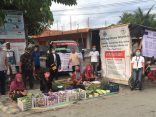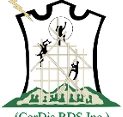The bells rang at rapid intervals. Women, children, youth, elderly, and men are making their way to the identified pick-up points within the village. Bringing with them some food, drinking water, clothing, blankets and sleeping mats, they wait for the vehicles that will transport them to their designated evacuation centres. Members of the Evacuation Unit of the BDRRMC are supervising the process, ensuring that everyone responded to the warning. Meanwhile, members of the Rescue Unit are assisting those with special needs like the sick, elderly, persons with disability, pregnant women, and those with young children.
Earlier, the bells were rung at measured intervals. The emergency meeting of the BDRRMC concluded that the whole village be alerted for possible evacuation. The Early Warning Unit announced on megaphones that the downpour was expected to continue. “It’s very likely that in a few hours the whole village will be submerged in deep flood-water and the bridge leading to the town centre may become impassable,” they said. Members of the Damage Control team made rounds in the area, clearing water-ways and drainage canals.
Upon arrival at the evacuation centres, the assigned room marshals from the Evacuation team had the evacuees sign on their names on the master list. That will confirm that those who were supposed to be there were actually present.
It was a community drill. At least 1,200 individuals from Barangay Panian in Saint Bernard have participated in the activity conducted on September 3, 2011. People from seven other barangays did the same and are now housed in their designated “evacuation centres.” Some were at the other schools, others in churches, and some in designated private homes.
The drill was conducted to test the Contingency Plans of the participating barangays and that of the municipality. It aimed to practice and test the effectiveness of their early warning system, evacuation plans, the Disaster Risk Reduction and Management structures and the readiness of the people. For Panian, this drill was their second. Their first time was during ACCORD-2, in 2009.
Panian and other communities in the municipality have experienced hazards and disasters in the past. It has become a normal part of the people’s lives. However, at the time, there had been no systems that guided the emergency response. “Sa una, wala pa mi kasabot kung unsay buhaton. Ang BDCC nakasuwat lang sa bungbong sa Barangay Hall” (We did not fully understand what to do back then. The BDCC was just an organizational structure displayed on the wall of the Barangay Hall), said Punong Barangay Ruperto Rafols. He was on his second term as barangay chair when Panian became part of ACCORD-2 Project. Prior to that, he served as barangay councillor for three terms. Kap Rafols, as he is fondly called, admitted that before ACCORD, members of the Barangay Disaster Coordinating Council did not understand how to guide their constituents during emergencies. There was no local warning system. People left their homes for safer grounds only when flood-water was already high. Without an evacuation plan, they were also scattered around the village, with no way of knowing if a family has been swept away by the water and had gone missing.
(Insert ch 5 2.jpg)
In ACCORD-2 however, Panian has conducted Contingency Planning activities. Led by their soft-spoken but very active and well-respected Kapitan, barangay officials, and selected health workers, tanods, “senior citizens,” youth, and non-leader men and women went thru training in CBDRM, disaster preparedness and Contingency Planning. In DPT, they understood the duties and functions of the different task units of the BDCC. They also established that the worst situation that could happen and which they need to prepare for is “mabilis at malawakang pagbaha na may isang metro ang lalim at tatagal ng isang buwan dulot ng tuloy-tuloy na pag-ulan at pag-apaw ng Panian River” (fast rising flood affecting a large area of the barangay that will stay as long as one month due to the continuous rains that will cause the overflow of the Panian river).
Based on the identified worst-case scenario, the community drafted an early warning system. A rain-gauge and water-level gauge was installed in Panian, which also forms part of the municipal-level warning system of Saint Bernard. Among all the EWS stations in the municipality, Panian is one of the most faithful in its duties. Rainfall and water-level reading has become one of the standard tasks of barangay officials during their weekly turns as “official-of the-day.” Those who fail to record and report the readings are fined P150 per day. As a result, Panian is gradually establishing localized rainfall thresholds for floods.
The community also formulated their evacuation plan. Contrary to their practice in the past, they decided that they will evacuate outside of their barangay should the worst scenario happen. This way, they avoid the risk of being isolated from the rest of the town and thereby from help. Together with members of the MDRRMC, BDRRMC members from Panian successfully negotiated with administrators of Saint Bernard Central School and the privately-owned Cristo Rey High School that the latters’ doors be opened for Panian residents during emergencies. Now Panian has an evacuation plan complete with room assignments for each household and designated room marshals.
Upon completion of a draft Contingency Plan, the BDRRMC then organized purok meetings to validate and explain to their constituents the contents of the CP. These activities served as their first test on familiarity of their duties. With shaking hands and hand-written guides, representatives from each task unit stood in front of their village folks to introduce the members of their respective teams and explain their duties and functions. The Warning Task Unit also explained their EWS while the Evacuation team discussed the evacuation plan.
With the whole village informed of their Contingency Plan, Panian prepared for a drill. Kap Rafols and the Communication team of the BDRRMC led the coordination work. They prepared and disseminated letters to invite other barangays and the Municipal LGU to observe their first community drill. Lessons from their first drill were used in updating their Contingency Plan.
When heavy rains poured over Visayas and Mindanao, late in December 2010 until January 2011, Panian and the rest of Saint Bernard had the chance to actually execute their Contingency Plans. In Panian, the rain-gauge and water-level gauge were monitored as often as 3-4 hours interval. Even before the MDRRMC called for evacuation and before the landslide incident in Barangay Bolod-Bolod, Kap Rafols had already called for an emergency meeting of the BDRRMC. Bracing for the floods, the Warning Unit made rounds of the barangay to alert the people for possible evacuation. Twenty-one households from the most at-risk areas in Purok 2 were initially accommodated in other private homes, in preparation for a potential full evacuation.
“Bentahe gayud nga nagContingency Planning mi kay sa panahon nga parehas niadtong January, mas kabalo na mi unsay angayan buhaton,” (It is really fortunate that we have undertaken Contingency Planning so that on occasions like what happened in January, we already know what to do), Kap Rafols concluded.




